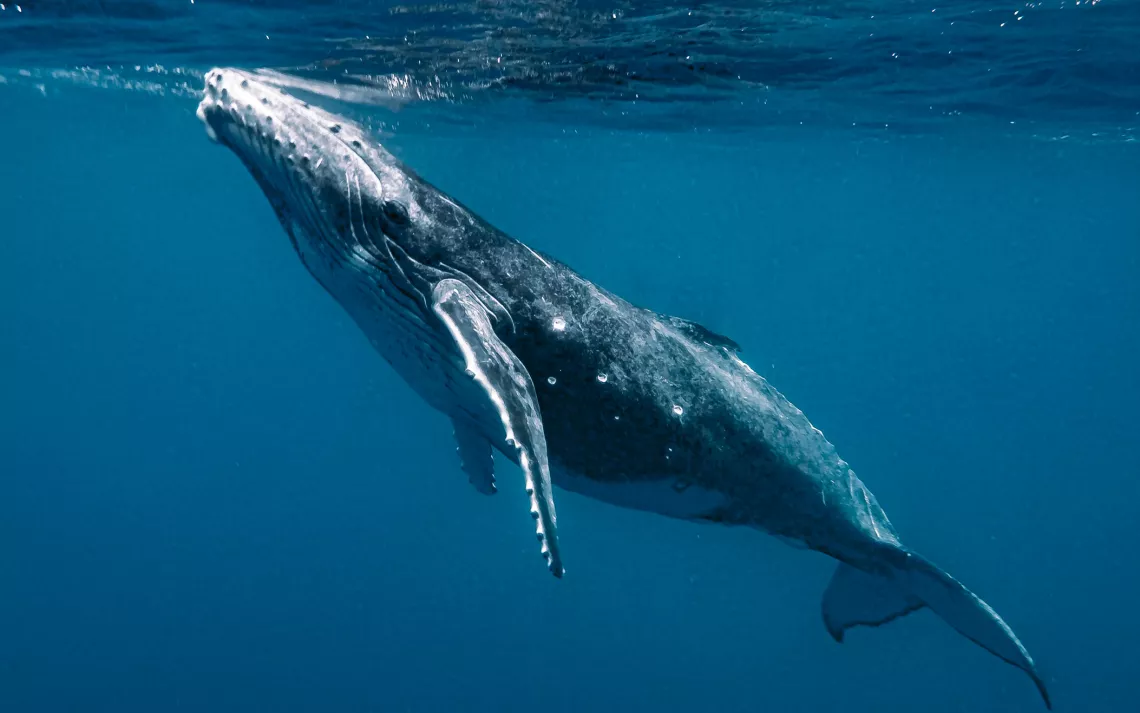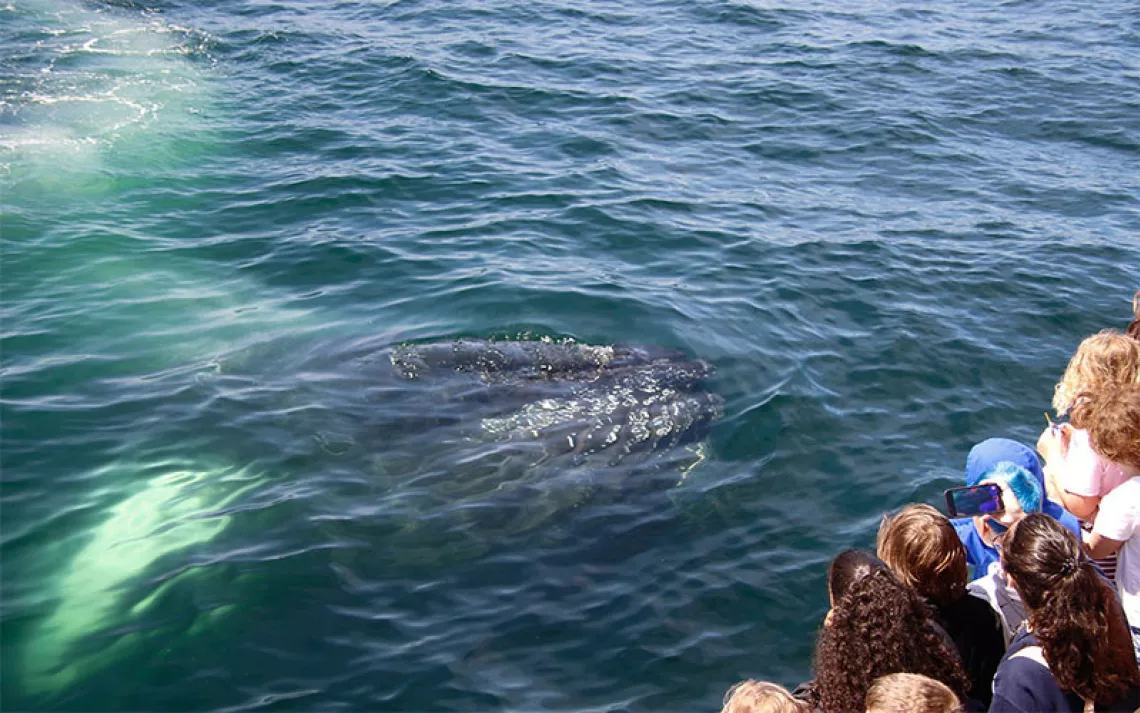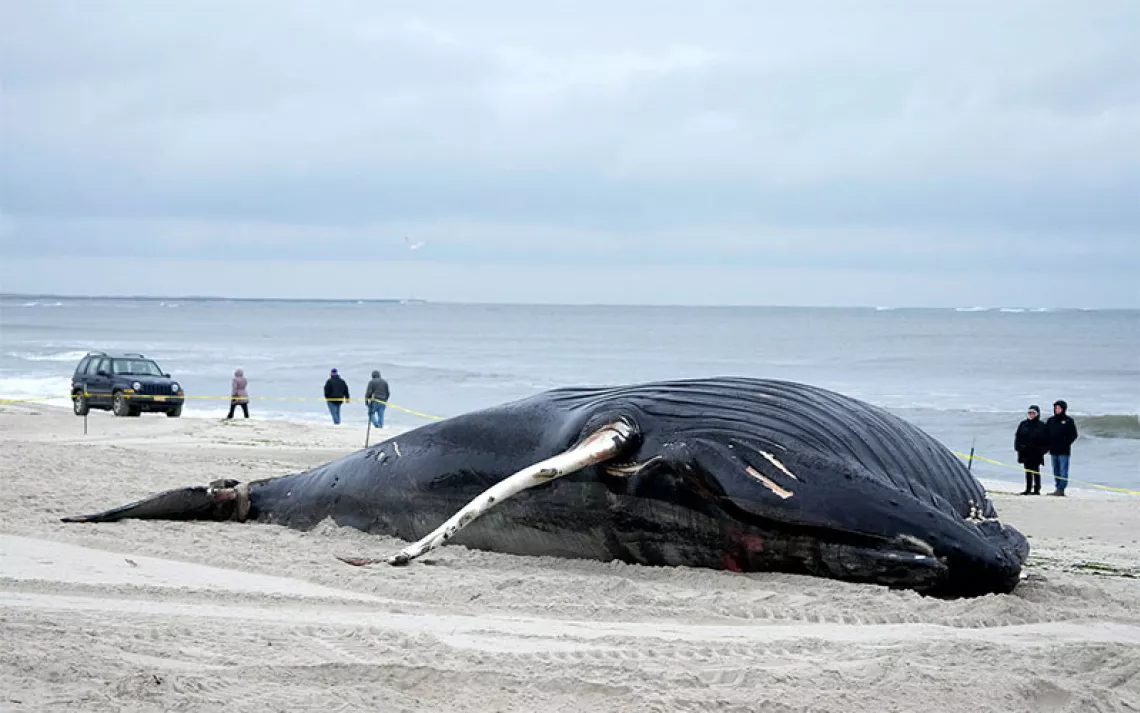Interview With a Whale
This is a water planet. Seen from space, the whole sphere glows blue.

This is a water planet. Seen from space, the whole sphere glows blue. The vast majority of earthly life takes place in marine ecosystems. If you're going to call yourself a naturalist, which I did, you should know at least a little about what goes on out there, down there, which I didn't for quite a long time. Then I teamed up with a photographer named Flip Nicklin on a National Geographic story about America's National Marine Sanctuary System, and my own life underwent a sea change. Soon I was aboard one boat or another for days on end, starting to learn about oceans at last.
Flip grew up swimming, surfing, and working as a scuba instructor for his family's dive shop in San Diego. Able to free-dive to 80 feet without a tank, he quite possibly qualifies as some sort of marine mammal himself by now. After I got certified for scuba, he guided me down to explore the seafloors of several marine sanctuaries. We weren't looking for whales. But, submerged sometimes for two or three hours a day, I was able to sense for the first time what existence is like in an environment where you detect nearby movements as pressure waves on your skin, hear sounds directly through your skull, and move with equal ease in three dimensions with the flutter of a flipper.
Part of the North Pacific population of humpback whales travels each winter to the warm, clear waters around the Hawaiian Islands, gathering to breed and give birth. Flip had been photographing the leviathans there for years while his longtime friend and colleague Jim Darling, director of the West Coast Whale Research Foundation, studied their activities. Eventually, Flip took on the role of full research partner, bringing his cameras into play primarily to identify individual animals and record their behavior.
Flip and Jim had a routine of heading out from the harbor at Lahaina on Maui's northwest coast shortly after dawn. The eight-mile-wide Au'au Channel between Maui and Lanai tends to be calmest in the morning hours. A minimum of wind, waves, and throbbing boat engines makes it easier for Jim to pursue his chief interest, which is the humpback's long, elaborate, strangely beautiful, and continually changing song. While the whales may be out of view at times, they are seldom out of hearing. Wade into the ocean from any beach facing the Au'au Channel, duck underwater, and humpback voices will fill your ears: sequences of squeaks, ribbits, trumpet blasts, trombone-slide groans, and pulsating rumbles flowing in from near and far. Dive a bit deeper, below the noises from rolling surf, and the songs swell in volume and number until you begin to feel serenaded by an otherworldly chorus. Drop a hydrophone 30 feet down over the side of a boat, and, like Jim, you could start to pick out individual singers, find your way closer to the nearest one by moving in the direction of the loudest sounds, and document the animal's tunes with a recording device.
A Canadian scientist with a doctoral degree, Jim was able to offer impressive analyses of the notes' wavelengths and harmonics. He could identify rhythms and tell you how themes sung by the population change over time. But, as with breaching, he couldn't say why the whales were singing. His goal was to find an answer. At the time I showed up, he had already been probing the subject for 18 years.
DURING ONE OF MY FIRST DAYS on Jim's 24-foot speedboat, the good ship Never Satisfied, we went well out in the channel and drifted while the sounds caught by the hydrophone played through a speaker on deck. Clouds wreathed the islands' volcanic peaks above steep slopes that glowed green in the morning light. As the sun rose higher, the channel kept turning more blue and at the same time more transparent, until it was like a second sky. Jim located a singer and gradually homed in on its location, until the notes came rising up through the water around us and reverberated in the hull. Moments later, we could make out the animal itself suspended about 50 feet below. Then Jim announced that the whale was coming up. Close.
The humpback cruised right next to the Never Satisfied and stopped, hovering with its barnacle-stippled nose thrust out of the water. Then it continued making slow passes, singing during some of them. Our visitor paused to croon directly beneath the boat, investigated the hydrophone, put its head right next to the device as if auditioning, rubbed against the hydrophone, rose, and rubbed gently against the Never Satisfied. This meeting was turning into a mugging, which is how whale watchers describe incidents of an animal interacting closely with a boat. They don't occur often and seldom last long. For a singer to show so much interest was rarer still. The fascination was mutual. All season Jim and Flip hadn't encountered a humpback quite this curious or friendly or sexually attracted or whatever was in progress.
Surfacing by the boat again, the whale lifted its head high out of the water. It reversed position and lifted its tail above our heads. After slowly sinking back, the animal resumed making passes, rolling to bring an eye nearer the surface and stare up at us.
The whale stayed around so long that Flip eased into the water to see what he could make out through a face mask and to try to photograph the animal's behavior. He motioned for me to follow. I passed from the gunwale into the Pacific, took a quick breath through the snorkel, and ducked my head under. Whereas I had barely been able to see 50 blurry feet into the water from the ship's deck, I suddenly had a crisp view stretching in every direction for 100 to 150 feet. It was an opalescent universe of borderless blue, gradually dimming to gray in the distance. And it was empty save for flecks of plankton drifting by. Then I looked past my feet.

Sign up to receive Sierra News & Views
Get articles like this one sent directly to your inbox weekly.
With this action you affirm you want to receive Sierra Club communications and may vote on policy designated by the Sierra Club Board.
The whale was suspended head down with its pectoral fins spread as if frozen in a swan dive, a pose often assumed by singers. Its music came straight through my flesh and played loudly in my bones. I felt strummed. After a while, the melody was replaced by a series of ascending whoops, and the whale came rising from the depths. I don't recall the exact sequence, but I know that this enormity, this sentient presence with a body about 7 times my length and 400 times my weight, approached very closely, eyeing me, and its passing took an achingly long time, and at one point a pectoral fin swept by inches over my head. I know the whale turned and came directly toward me once more, closing the distance much too fast for me to react. At the last instant, the nose began to pitch slightly down, and the rest of the head followed in an arc that left me four feet above it, awash in whale currents. Again the animal rolled onto its side and looked at me. Then it rolled farther until it was on its back, and the white, grooved belly slid on past and away.
Next came another approach straight at me. This time the humpback flared its pectoral fins and braked less than a yard from my face. We floated there nose to nose, scarcely moving. I rose slightly to look above the surface. There was nothing but more whale head in view. The thing was studded with tubercles--the stove-bolt-like knobs unique to humpback noses. Behind them stretched the long, flat plane formed by the upper part of the jaw, or rostrum, and dark, gray, wet skin gradually sloped up from that toward the animal's back like a hill. The whale tilted head up, and a still wider expanse of whitish, pleated throat filled my view. I sank a few feet, and it was more whale all the way down; the animal's underside only broadened. Songs of other humpbacks came throbbing through me while my own blood pounded in my ears.
I felt wary and off balance but never really frightened. I was too overwhelmed, treading water slowly while facing a force so utterly beyond mine that I couldn't begin to make sense of the situation. There was simply no experience in my lifetime to use as a reference. I hadn't come with any preconceptions about whales being extraordinarily gentle or wise, but I somehow trusted that the force hovering before me was benign. This megamammal appeared able to keep track of exactly where I was and to fine-tune its movements accordingly. It showed no intention of doing anything except making inquiries after its fashion. I was before an intelligent, purposeful, immanent being. It had questions.
Maybe this is what an interview with God would be like.
 The Magazine of The Sierra Club
The Magazine of The Sierra Club



